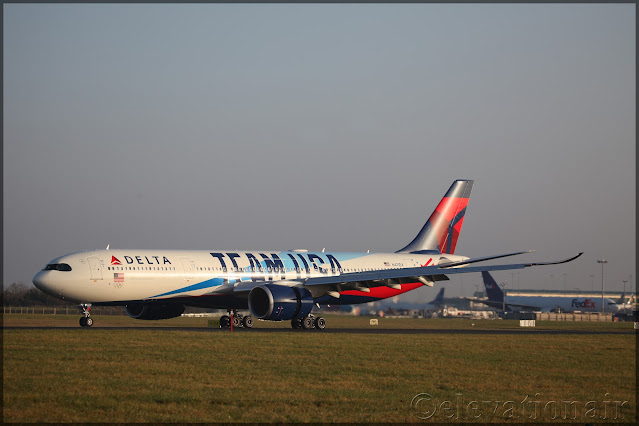US carrier Delta Airlines debuted its first Airbus A330NEO on New York JFK to Dublin as N411DX Airbus A330-941 msn 1991 operated DAL44 arriving 0952 local departing as DAL45 1144 local in special TEAM USA Livery. The Team USA inspired Airbus A330-900 celebrates Delta’s new eight-year partnership with Team USA, which runs through the Beijing Winter Games 2022, LA28 Olympic and Paralympic Games.
Delta’s Senior Executive Vice President and Chief Operating Officer Gil West said “The next-generation engine technology from Rolls-Royce which powers the A330neo provides compelling operating economics, superior fuel performance and the range and coverage for our transoceanic needs going forward.” (Delta Press Release 16Nov18).
The aircraft was delivered Toulouse to Tokyo Narita on 29th May 2021 in a three class configuration (29 Business Class , 28 Premium Economy , 224 Economy) powered by Rolls Royce RR Trent 7000-72 engines, that produce a 25% lower fuel burn than previous generation aircraft with a range of 6,550 nautical miles, delivering a 20 % operating cost savings per seat over the Boeing 767-300ER aircraft it will replace.
The aircraft features Delta’s new in in-flight entertainment system, developed by Delta Flight Products, the airline’s wholly owned cabin interior start-up. It is equipped with high-speed 2Ku internet connectivity and customers will have access to free mobile messaging. According to Flightradar24 data the aircraft operated its first commercial service on 17th June as DAL444 from Seattle (SEA) to Honolulu (HNL).
Delta Airlines was the launch customer for the Airbus A330-900, ordering 25 in November 2014 with an additional 10 ordered in 2018, expanding its order book from 25 to 35 aircraft of which 12 have been delivered to date, replacing older Boeing 767-300ERs retire in the years ahead at the end of their serviceable life cycle. The aircraft are operated on on medium-haul North Atlantic markets as well as select routes connecting the U.S. West Coast and Asia.
Image courtesy of Elevationair
Irish Aviation Research Institute © 26 January 2022 All Rights Reserved

